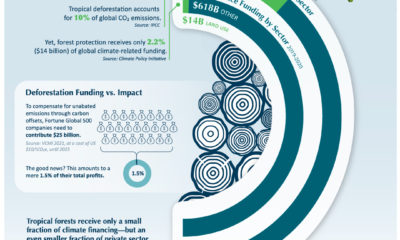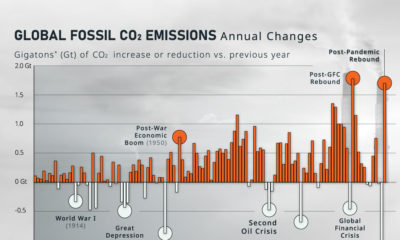Not only has coal been singled out as a primary source of carbon emissions and air pollution, but it’s also been getting phased out in favor of cheap natural gas in some regions around the world. In the U.S., electricity generation from coal has been dropping since the late 2000s, and in Europe the departure from coal has accelerated even quicker. In fact, it’s estimated that European coal power output could fall 23% in 2019 alone.
A Different Global Story
However, despite a growing consensus around the use of thermal coal in the West, the global story is actually quite different. Today’s animation from SVT Nyheter details every coal power plant in the world from 1927 to 2019, and it shows that coal power — especially in South Asia — has continued to ramp up.
As of 2019, there are an estimated 2,425 coal-fired power plants in the world, combining for an operating capacity of about 2,000 GW and roughly 15 billion tonnes of CO₂ emissions.
Global Tipping Point?
Since 2010, there have been hundreds of new coal power plants commissioned — and almost all of them can be found somewhere in Asia: However, it seems that this could be the year that the story changes. Preliminary data suggests that Indian coal consumption could drop in 2019 for the first time in over a decade. Meanwhile, it’s expected that China’s growing coal capacity could be fully offset by decreasing use of the fossil fuel in developed nations. As a result, according to Carbon Brief, global coal power generation could fall 3% in 2019:
If this trend continues, it could be a sign of a tipping point in global coal consumption — and if the sentiment around coal shifts the same way in China, the potential impact could be amplified even further. Will 2020 provide additional evidence towards a global sea change in coal dependence, or is 2019 just a blip on the radar? on
#1: High Reliability
Nuclear power plants run 24/7 and are the most reliable source of sustainable energy. Nuclear electricity generation remains steady around the clock throughout the day, week, and year. Meanwhile, daily solar generation peaks in the afternoon when electricity demand is usually lower, and wind generation depends on wind speeds.As the use of variable solar and wind power increases globally, nuclear offers a stable and reliable backbone for a clean electricity grid.
#2: Clean Electricity
Nuclear reactors use fission to generate electricity without any greenhouse gas (GHG) emissions.Consequently, nuclear power is the cleanest energy source on a lifecycle basis, measured in CO2-equivalent emissions per gigawatt-hour (GWh) of electricity produced by a power plant over its lifetime. The lifecycle emissions from a typical nuclear power plant are 273 times lower than coal and 163 times lower than natural gas. Furthermore, nuclear is relatively less resource-intensive, allowing for lower supply chain emissions than wind and solar plants.
#3: Stable Affordability
Although nuclear plants can be expensive to build, they are cost-competitive in the long run. Most nuclear plants have an initial lifetime of around 40 years, after which they can continue operating with approved lifetime extensions. Nuclear plants with lifetime extensions are the cheapest sources of electricity in the United States, and 88 of the country’s 92 reactors have received approvals for 20-year extensions. Additionally, according to the World Nuclear Association, nuclear plants are relatively less susceptible to fuel price volatility than natural gas plants, allowing for stable costs of electricity generation.
#4: Energy Efficiency
Nuclear’s high energy return on investment (EROI) exemplifies its exceptional efficiency. EROI measures how many units of energy are returned for every unit invested in building and running a power plant, over its lifetime. According to a 2018 study by Weissbach et al., nuclear’s EROI is 75 units, making it the most efficient energy source by some distance, with hydropower ranking second at 35 units.
#5: Sustainable Innovation
New, advanced reactor designs are bypassing many of the difficulties faced by traditional nuclear plants, making nuclear power more accessible.
Small Modular Reactors (SMRs) are much smaller than conventional reactors and are modular—meaning that their components can be transported and assembled in different locations. Microreactors are smaller than SMRs and are designed to provide electricity in remote and small market areas. They can also serve as backup power sources during emergencies.
These reactor designs offer several advantages, including lower initial capital costs, portability, and increased scalability.
A Nuclear-Powered Future
Nuclear power is making a remarkable comeback as countries work to achieve climate goals and ultimately, a state of energy utopia. Besides the 423 reactors in operation worldwide, another 56 reactors are under construction, and at least 69 more are planned for construction. Some nations, like Japan, have also reversed their attitudes toward nuclear power, embracing it as a clean and reliable energy source for the future. CanAlaska is a leading exploration company in the Athabasca Basin, the Earth’s richest uranium depository. Click here to learn more now. In part 3 of the Road to Energy Utopia series, we explore the unique properties of uranium, the fuel that powers nuclear reactors.





























